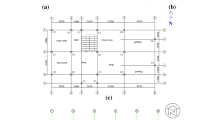Abstract
In recent years, the use of Pre-engineered buildings (PEB) has become more popular due to their important advantages over conventional steel structures (CSB) such as cost-effectiveness, faster construction, low maintenance, consistent span, reasonable earthquake resistance, the capability of offering column-free area, etc. This paper focuses on the analytical study of the structural behavior of a PEB provided with different types of bracings (viz. X, V, K, and diagonal) considering all the seismic zones (i.e., II, III, IV, and V) and medium type of soil. The analysis of a PEB of size 22 m × 44 m is done using Staad Pro software considering wind and seismic forces for determining the efficient type of bracing that will minimize the structural responses viz. displacement and natural time period. The results of the study indicate that the PEB provided with diagonal bracing reduces displacement and natural time period by 13% and 15.80%, respectively, when compared with the corresponding average values of displacement and natural time period of PEBs provided with X, V, and K types of bracings. The study concludes that the provision of diagonal bracing contributes to improving the performance of PEB in all the seismic zones.







Similar content being viewed by others
Data availability
The authors declare that data supporting the findings of this study are available within the paper.
References
Arzani, H., Kaveh, A., & Kamalinejad, M. (2019). Optimal design of pitched roof rigid frames with non-prismatic members using quantum evolutionary algorithm. Periodica Polytechnica Civil Engineering. https://doi.org/10.3311/PPci.14091.
Bharmal, P. P., Kumbhar, P. D., & Gumaste, K. S. (2023). Comparative study on the behaviour of conventional and pre-engineered buildings provided with different types of bracing. Asian Journal of Civil Engineering. https://doi.org/10.1007/s42107-023-00787-y.
Gawade, M. D., & Waghe, U. P. (2018). Study of pre-engineered building concept. Journal of Research in Engineering and Applied Sciences (JREAS), 3(03), 88–91. ISSN. 2456-6403.
Harish, J.V., Patel, V.B., & Arekar, V.A. (2016). Parametric study of various pre-engineered buildings. International Journal of Advance Research in Engineering, Science & Technology, 3(4), https://www.researchgate.net/publication/342549844.
IS: 1893 (Part 1). (2016). Bureau of Indian standards New Delhi. Criteria for earthquake resistant design of structures, IS 1893 (Part 1):2016.
IS: 875 (Part 3). (2015). Bureau of Indian standards, New Delhi. Indian standard—code of practice for design loads (other than earthquake) for building and structures: Part 3—Wind loads, IS 875 (Part 3): 2015.
IS: 800. (2007). Bureau of Indian standards, New Delhi. Indian standard general construction in steel code of practice, IS 800: 2007.
Kaveh, A., & Ghafari, M. H. (2018). Geometry and sizing optimization of steel pitched roof frames with tapered members using nine metaheuristics. Iranian Journal of Science and Technology—Transactions of Civil Engineering. https://doi.org/10.1007/s40996-018-0132-1.
Kaveh, A., Kabir, M. Z., & Bohlool, M. (2018). Optimal design of multi-span pitched roof frames with tapered members. Periodica Polytechnica Civil Engineering. https://doi.org/10.3311/PPci.13107.
Kaveh, A., Mahdavi, V. R., & Kamalinejad, M. (2017). Optimal design of pitched roof frames with tapered members using ECBO algorithm. Smart Structures, and Systems., 19(6), 643–652. https://doi.org/10.12989/sss.2017.19.6.643.
Kumar, G. S., & Varghese, K. M. (2020). Comparative analysis on pre-engineered and conventional buildings with diagonal braces. International Research Journal of Engineering and Technology, 07(06), 3668–3671.
Rahman, F. U. (2023). https://theconstructor.org/building/pre-engineered-steel-building-components-difference-advantages/37187/.
Sah, S. K., Kangda, M. Z., Sathe, S., & Mate, N. (2022). A state of art review on analysis and design of pre-engineered buildings. Materials Today Proceedings., 77, 1–7.
Sai, V.V., Poluraju, P., & Rao, B.V. (2021). Structural performance of pre engineered building: a comparative study. In: International Conference on Advances in Civil Engineering (ICACE 2021), https://doi.org/10.1088/1757-899X/1197/1/012086.
Sharma, L., Taak, N., & Mishra, P.K. (2021). A comparative study between the pre-engineered structures and conventional structures using Staad Pro. Materials today: Proceedings. https://www.sciencedirect.com/science/article/abs/pii/S2214785320406601.
Tale, S., & Vasugi, K. (2019). Effect of bracing under different loading for conventional and pre-engineering industrial structure. International Journal of Recent Technology and Engineering. https://www.ijrte.org/wp-content/uploads/papers/v8i1/A2969058119.pdf.
Varma, A., & Chandak, R. (2022). Analysis and design of pre-engineered building with different parameters. International Journal for Research in Applied Science & Engineering Technology (IJRASET). https://doi.org/10.22214/ijraset.2022.40982.
Acknowledgements
The authors are grateful to the Director, Rajarambapu Institute of Technology (RIT), Rajaramnagar, and the Head of Department, Civil Engineering, RIT for motivating and providing the required facilities in carrying out this study.
Funding
The authors declare that no funds, grants, or other support were received during the preparation of this manuscript.
Author information
Authors and Affiliations
Contributions
All authors contributed to the study’s conception and design. Material preparation, data collection, and analysis were performed by PPB, PDK, and KG. The first draft of the manuscript was written by PPB and all authors commented on previous versions of the manuscript. All authors read and approved the final manuscript.
Corresponding author
Ethics declarations
Conflict of interest
The authors have no relevant financial or non-financial interests to disclose.
Additional information
Publisher's Note
Springer Nature remains neutral with regard to jurisdictional claims in published maps and institutional affiliations.
Rights and permissions
Springer Nature or its licensor (e.g. a society or other partner) holds exclusive rights to this article under a publishing agreement with the author(s) or other rightsholder(s); author self-archiving of the accepted manuscript version of this article is solely governed by the terms of such publishing agreement and applicable law.
About this article
Cite this article
Bharmal, P.P., Kumbhar, P.D. & Gumaste, K.S. Structural behavior of pre-engineered industrial buildings provided with different types of bracings in various seismic zones. Asian J Civ Eng 25, 1531–1538 (2024). https://doi.org/10.1007/s42107-023-00859-z
Received:
Accepted:
Published:
Issue Date:
DOI: https://doi.org/10.1007/s42107-023-00859-z





